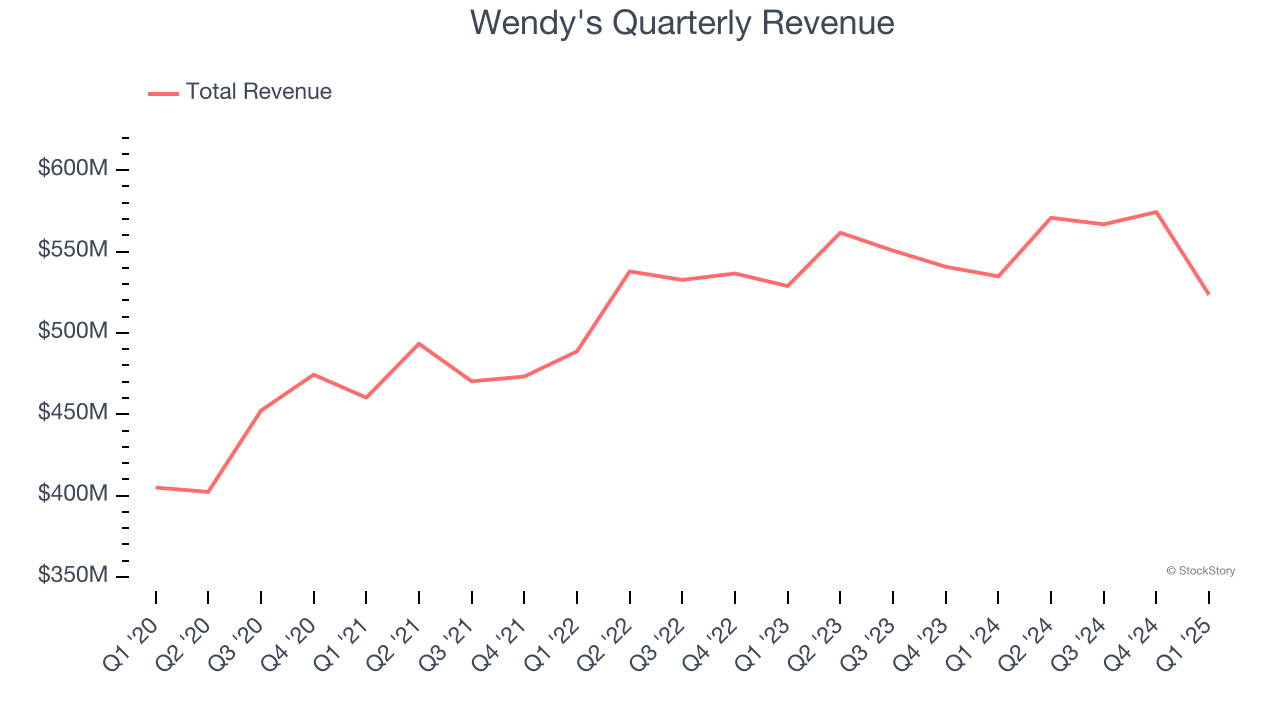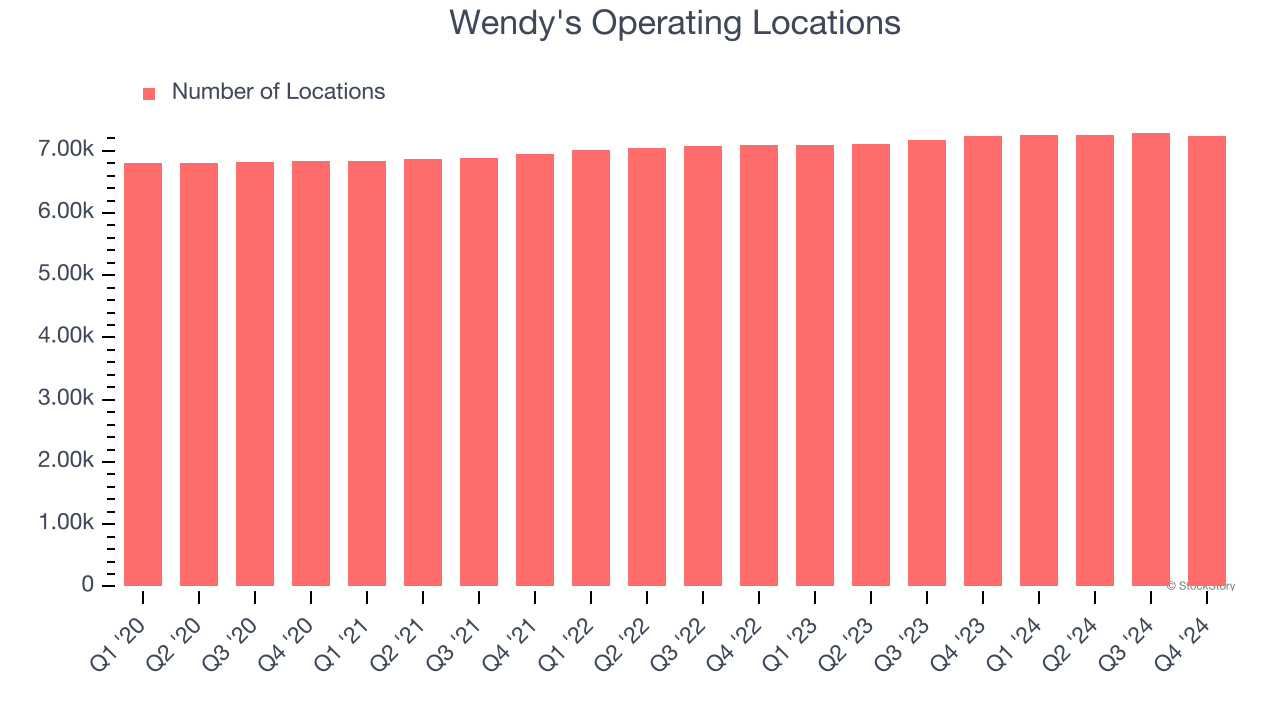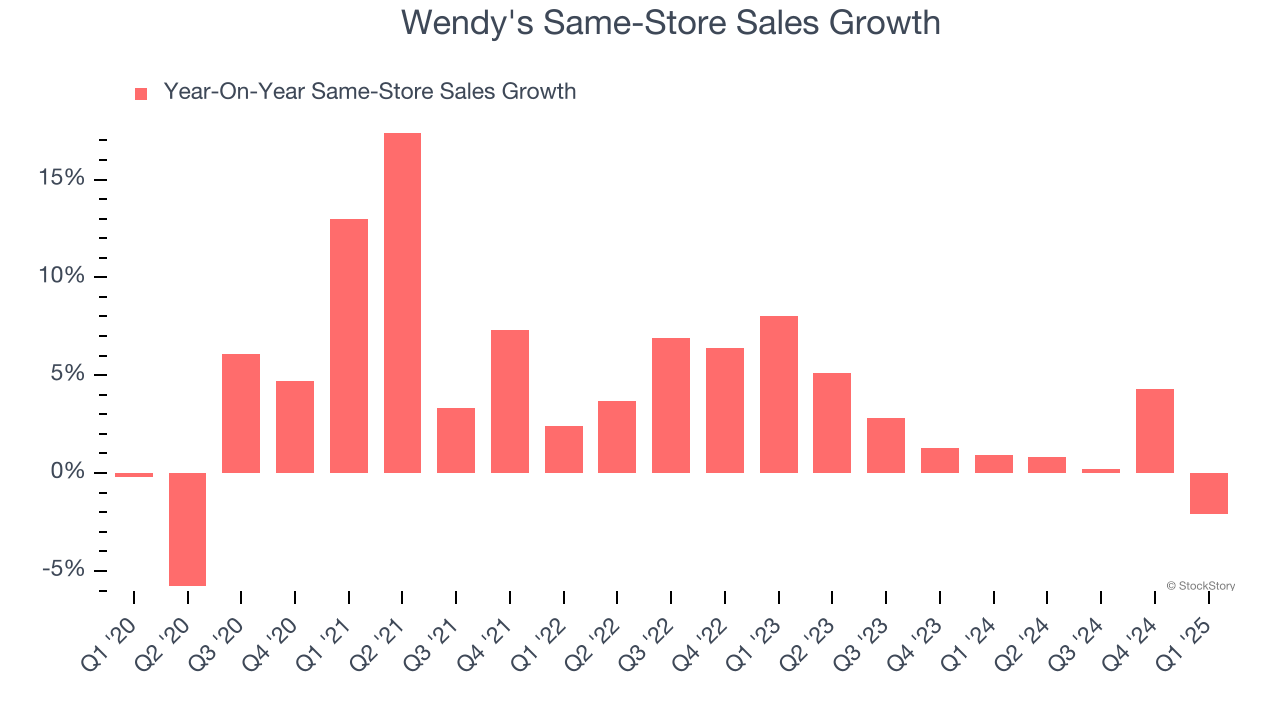
Fast-food chain Wendy’s (NASDAQ:WEN) met Wall Street’s revenue expectations in Q1 CY2025, but sales fell by 2.1% year on year to $523.5 million. Its non-GAAP profit of $0.20 per share was in line with analysts’ consensus estimates.
Is now the time to buy Wendy's? Find out by accessing our full research report, it’s free.
Wendy's (WEN) Q1 CY2025 Highlights:
- Revenue: $523.5 million vs analyst estimates of $524.9 million (2.1% year-on-year decline, in line)
- Adjusted EPS: $0.20 vs analyst estimates of $0.20 (in line)
- Adjusted EBITDA: $124.5 million vs analyst estimates of $122.5 million (23.8% margin, 1.7% beat)
- Management lowered its full-year Adjusted EPS guidance to $0.95 at the midpoint, a 5% decrease
- Operating Margin: 15.9%, in line with the same quarter last year
- Free Cash Flow Margin: 12.9%, down from 15.5% in the same quarter last year
- Same-Store Sales fell 2.1% year on year (0.9% in the same quarter last year)
- Market Capitalization: $2.45 billion
"We continued to deliver for our customers during the first quarter. In the U.S. we held both traffic and dollar share in a challenging consumer environment, and in our International business we grew systemwide sales by 8.9%," said Kirk Tanner, President and Chief Executive Officer.
Company Overview
Founded by Dave Thomas in 1969, Wendy’s (NASDAQ:WEN) is a renowned fast-food chain known for its fresh, never-frozen beef burgers, flavorful menu options, and commitment to quality.
Sales Growth
A company’s long-term sales performance is one signal of its overall quality. Any business can experience short-term success, but top-performing ones enjoy sustained growth for years.
With $2.24 billion in revenue over the past 12 months, Wendy's is a mid-sized restaurant chain, which sometimes brings disadvantages compared to larger competitors benefiting from better brand awareness and economies of scale.
As you can see below, Wendy's grew its sales at a tepid 5.5% compounded annual growth rate over the last six years (we compare to 2019 to normalize for COVID-19 impacts) as it barely increased sales at existing, established dining locations.

This quarter, Wendy's reported a rather uninspiring 2.1% year-on-year revenue decline to $523.5 million of revenue, in line with Wall Street’s estimates.
Looking ahead, sell-side analysts expect revenue to grow 1.1% over the next 12 months, a deceleration versus the last six years. This projection doesn't excite us and suggests its menu offerings will face some demand challenges.
Here at StockStory, we certainly understand the potential of thematic investing. Diverse winners from Microsoft (MSFT) to Alphabet (GOOG), Coca-Cola (KO) to Monster Beverage (MNST) could all have been identified as promising growth stories with a megatrend driving the growth. So, in that spirit, we’ve identified a relatively under-the-radar profitable growth stock benefiting from the rise of AI, available to you FREE via this link.
Restaurant Performance
Number of Restaurants
Wendy's opened new restaurants quickly over the last two years, averaging 1.5% annual growth, faster than the broader restaurant sector.
When a chain opens new restaurants, it usually means it’s investing for growth because there’s healthy demand for its meals and there are markets where its concepts have few or no locations.
Note that Wendy's reports its restaurant count intermittently, so some data points are missing in the chart below.

Same-Store Sales
The change in a company's restaurant base only tells one side of the story. The other is the performance of its existing locations, which informs management teams whether they should expand or downsize their physical footprints. Same-store sales gives us insight into this topic because it measures organic growth at restaurants open for at least a year.
Wendy’s demand within its existing dining locations has been relatively stable over the last two years but was below most restaurant chains. On average, the company’s same-store sales have grown by 1.7% per year. This performance suggests it should consider improving its foot traffic and efficiency before expanding its restaurant base.

In the latest quarter, Wendy’s same-store sales fell by 2.1% year on year. This decline was a reversal from its historical levels.
Key Takeaways from Wendy’s Q1 Results
It was encouraging to see Wendy's beat analysts’ EBITDA expectations this quarter. On the other hand, its full-year EPS guidance missed and its same-store sales fell slightly short of Wall Street’s estimates. Overall, this was a softer quarter. The stock remained flat at $12.52 immediately after reporting.
So should you invest in Wendy's right now? When making that decision, it’s important to consider its valuation, business qualities, as well as what has happened in the latest quarter. We cover that in our actionable full research report which you can read here, it’s free.
